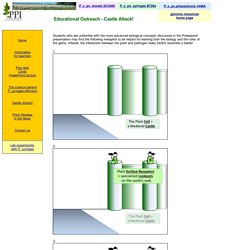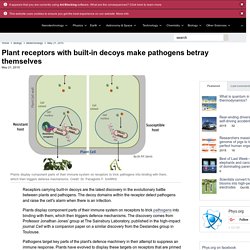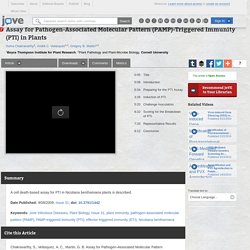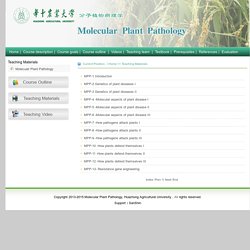

EducationalOutreach-CastleAttack. Students who are unfamiliar with the more advanced biological concepts discussed in the Powerpoint presentation may find the following metaphor to be helpful for learning both the biology and the rules of the game.

Afterall, the interaction between the plant and pathogen really DOES resemble a battle! 1. 2. 3. 4. 5. 6. 7. 8. 9. EducationalOutreach_Home. What is Vegevaders(TM)?

Vegevaders (TM) is a board game that allows students to experience through game-play the continuing co-evolution between plants and their microbial pathogens that occurs during the battle to detect/defend (plants) versus evade/invade (pathogens). The game has been successfully play tested with Middle School, High School, and Community College level students. The version of Vegevaders (TM) made available here is a prototype to be used exclusively for testing, evaluation, or quality control purposes.
Developers shall not be liable for any damages that result from the materials on this site or the performance of the products How do I get started? Play mat - a color PowerPoint file suitable for printing on 11x17 paper Cards - a color PowerPoint file to be printed double side PowerPoint lecture - Introduces students to the basic biology and rules of game play. Les plantes font de la résistance. Plant receptors with built-in decoys make pathogens betray themselves. Receptors carrying built-in decoys are the latest discovery in the evolutionary battle between plants and pathogens.

The decoy domains within the receptor detect pathogens and raise the cell's alarm when there is an infection. Plants display component parts of their immune system on receptors to trick pathogens into binding with them, which then triggers defence mechanisms. The discovery comes from Professor Jonathan Jones' group at The Sainsbury Laboratory, published in the high-impact journal Cell with a companion paper on a similar discovery from the Deslandes group in Toulouse. Pathogens target key parts of the plant's defence machinery in their attempt to suppress an immune response. Plants have evolved to display these targets on receptors that are primed to set off their alarm system. The research from Professor Jones' group shows one way in which plants perceive pathogens. The hypothesis that plants use decoys in this way was put forward last year. Assay for Pathogen-Associated Molecular Pattern (PAMP)-Triggered Immunity (PTI) in Plants.
Cite this Article Chakravarthy, S., Velásquez, A.

C., Martin, G. B. Assay for Pathogen-Associated Molecular Pattern (PAMP)-Triggered Immunity (PTI) in Plants. J. To perceive potential pathogens in their environment, plants use pattern recognition receptors (PRRs) present on their plasma membranes. Successful pathogens possess virulence factors or effectors that can suppress PTI and allow the pathogen to cause disease1.
We describe a cell death-based assay for PTI modified from Oh and Collmer4. Roger Beachy (Danforth Center) Part 1: Biology of Plant Virus Infection. Wilting in Tobacco caused by Black Shank. Haustoria Animation. Reconnaître les organismes : cryptogames - Hortidact. 6.2.

Reconnaître les organismes 6.2.3. : Maladies : cryptogamiques On parle de maladies cryptogamiques lorsque la plante est attaquée par un champignon parasite mais nous savons que tous les " cryptogames " ne provoquent pas des maladies. De la combinaison entre l'extériorisation visible d'un champignon parasite et la réaction du végétal attaqué résultent des symptômes qui vont permettre de déterminer une maladie ; par exemple : à la face inférieure des feuilles , pustules brunes disposées en cercles concentriques ( extériorisation visible d'un champignon appelé Puccinia pelargonii ) , et à la face supérieure , présence de taches décolorées jaunâtres ( réaction de la plante ) = ROUILLE ( définition de la maladie ) .
Les champignons parasites des plantes sont formés de filaments très fins , plus ou moins ramifiés et enchevêtrés , sans feuilles ni chlorophylle que l'on appelle le mycélium et qui est composé de cellules accolées les unes aux autres . Stress biotique des plantes moyens de lutte alternatifs. Une plante a beaucoup d’ennemis et ça la stresse !

Heureusement elle a des systèmes de résistance pour lutter contre les agressions tellement redoutées en agriculture : gel, sécheresse, maladies, ravageurs… Il existe des moyens, comme les éliciteurs pour les aider à résister et ainsi limiter les traitements. Le stress biotique : c’est quoi ? Il y a tout d’abord le stress biotique : déclenché par des champignons, des insectes, des bactéries, des adventices. Nous parlerons du stress abiotique dans le prochain article. Un peu d’histoire : dès 1961, Ross a montré qu’après inoculation d’une feuille de tomate avec une souche du virus de la mosaïque (TMV), il y avait une augmentation de la résistance des autres feuilles à ce virus ainsi qu’à d’autres pathogènes.
Par la suite, les progrès de la biologie cellulaire et moléculaire ont permis de démontrer des acquisitions ou des inductions de résistance. Comment répondent les plantes ? Eliciteurs : une solutions aux maladies ? RENEWABLE ENERGY. Molecular Plant Pathology. Molecular Plant Pathology. Home| Course description| Course goals| Course outline | Videos| Teaching team | Textbook| Prerequisites| References| Evaluation Teaching Materials.

Interaction virus-cellule et Pathogénie. Gene For Gene Hypothesis. Identification differential transcripts during Host pathogen interaction (Wheat puccinia system) Signaling Plant Pathogen.